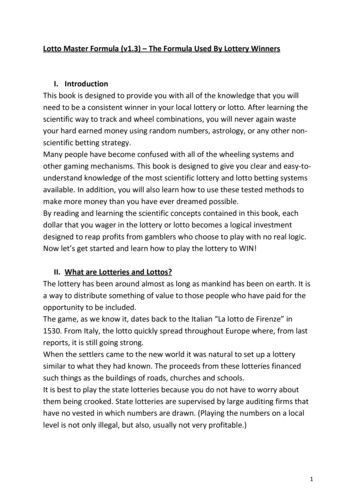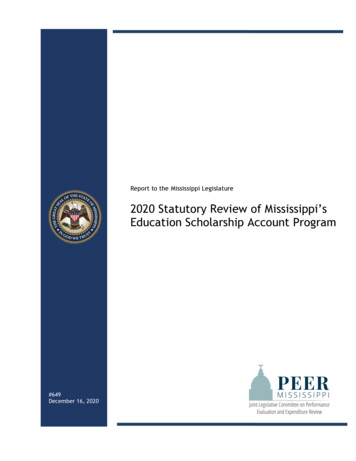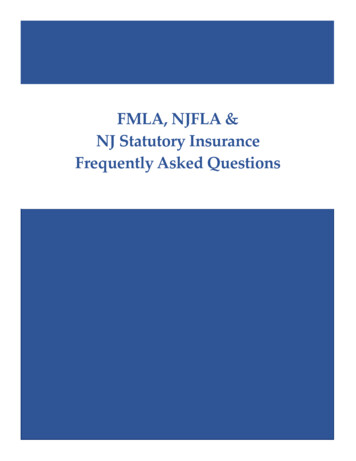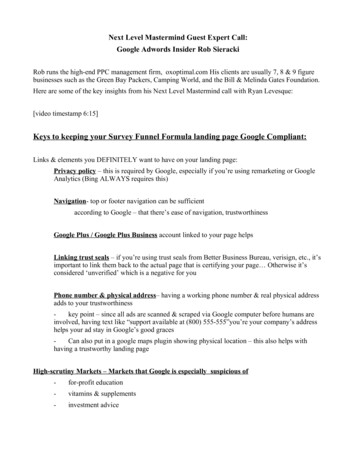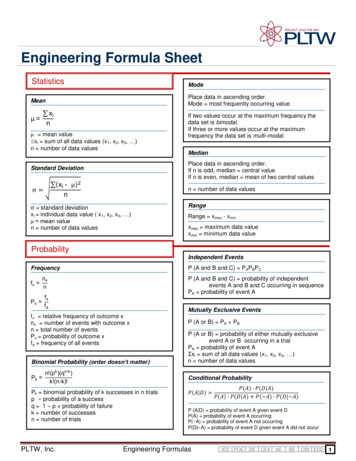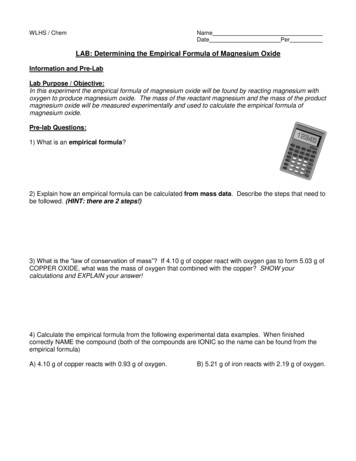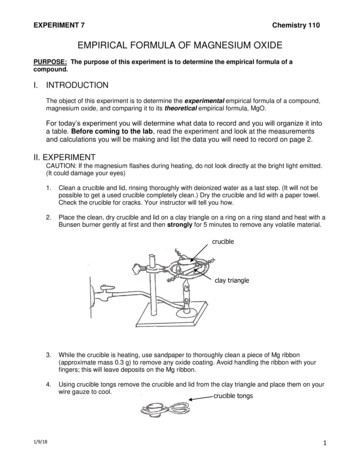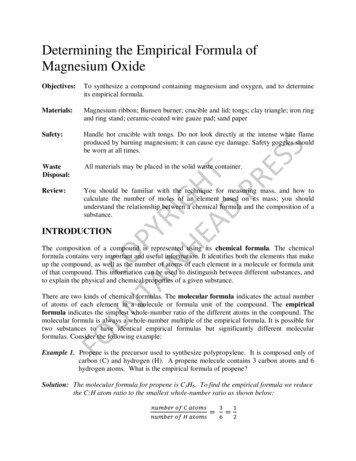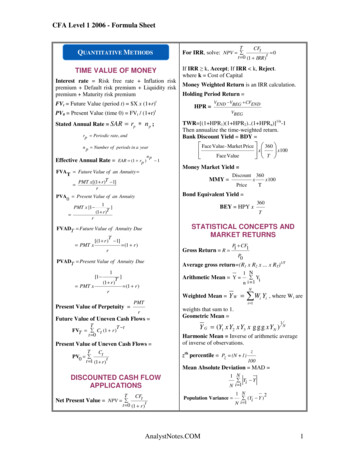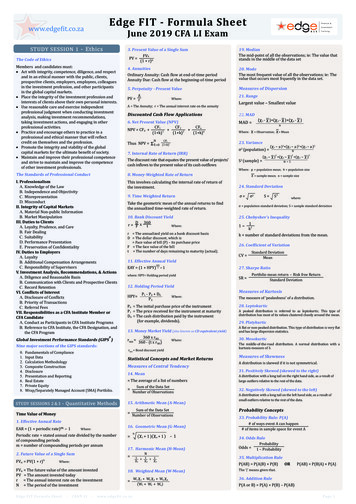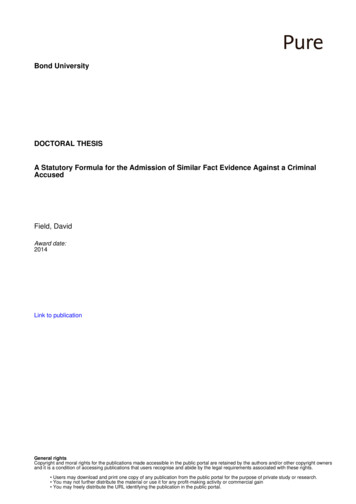
Transcription
Bond UniversityDOCTORAL THESISA Statutory Formula for the Admission of Similar Fact Evidence Against a CriminalAccusedField, DavidAward date:2014Link to publicationGeneral rightsCopyright and moral rights for the publications made accessible in the public portal are retained by the authors and/or other copyright ownersand it is a condition of accessing publications that users recognise and abide by the legal requirements associated with these rights. Users may download and print one copy of any publication from the public portal for the purpose of private study or research. You may not further distribute the material or use it for any profit-making activity or commercial gain You may freely distribute the URL identifying the publication in the public portal.
A STATUTORY FORMULA FOR THE ADMISSION OFSIMILAR FACT EVIDENCE AGAINST A CRIMINALACCUSEDDAVID J FIELDA thesis submitted in total fulfilment of the requirementsof the award of the degree of Doctor of PhilosophyFACULTY OF LAW, BOND UNIVERSITY DAVID FIELD, MARCH 2013
iABSTRACTThe law governing the admission, against a criminal accused, of what is referredto – sometimes inaccurately - as “similar fact evidence” has been allowed to acquire acomplexity which is not wholly justified. This complexity has arisen as the result oftwo errors which have operated in tandem for the best part of two centuries. The first isto regard all instances in which a criminal accused’s additional (usually prior) misdeedsare disclosed to a court as “similar fact evidence”, when in fact many such disclosuresinvolve facts which are far from similar. The second has been the attempt to rationaliseand regulate the law on such disclosure along the lines of the purpose for which it isadmitted, when in fact it is best approached from the standpoint of its natural relevanceto the case as a whole.This thesis corrects the first misconception, and identifies what is hereindescribed as “similar fact evidence properly so called”. It then proceeds to a criticalexamination of the historical treatment, by common law courts around the world, ofadditional misdeeds of a criminal accused, and argues that the current state of confusionsurrounding the subject is due primarily to the failure to acknowledge that relevance isthe key to admissibility.This has finally been recognised in both New Zealand and Canada. The SupremeCourt of Canada, in its ruling in Handy, also gave detailed guidance to all future trialjudges in that jurisdiction regarding those factors which made similar fact evidence so“relevant” to an issue in a case that it should be admitted, once the potential “prejudicialeffect” had been similarly identified. Handy also finally gave due recognition to the“doctrine of chances” reasoning identified by the American jurist Wigmore a centuryearlier. These outcomes in both New Zealand and Canada are finally fused into aproposed statutory formula for the admission of “similar fact evidence properly socalled”.
iiSIGNED CERTIFICATIONThis thesis is submitted to Bond University in fulfilment of therequirements of the Degree of Doctor of Philosophy.This thesis represents my own original work towards this research degree,except where due acknowledgement is made, and contains no materialwhich has been previously submitted for a degree or diploma at thisUniversity or any other institution.David J Field
iiiACKNOWLEDGMENTSI am fortunate in that, during most of the preparation of this thesis, I had twosupervisors. The first (in time) was Professor Lee Stuesser, of Bond University, andalso Manitoba and Lakehead Universities in Canada. He was joined in due course bymy academic colleague Professor William van Caenegam, Bond University.To them both I acknowledge my grateful thanks, not only for their expert guidance andwise counsel, but also for their tact and diplomacy in suggesting endless amounts ofmuch-needed editing, without which the end result would have been an ill-disciplinedcollection of volumes containing much unnecessary rhetoric and very little focus. Thefinal thesis is still a long one, but hopefully one which suggests a navigable coursethrough the rapids and torrents of two centuries of stormy water.My other academic colleagues at Bond – not the least of whom is my son Iain, whodemonstrated that it is possible to write a thesis while retaining one’s sanity – may nowtake comfort in the fact that I will no longer be using them as sounding boards for novel,if obscure, concepts. My wife Virginia may now also have unlimited access to ourhome computer. To them all – thank you for putting up with my five year obsession.
ivTABLE OF CONTENTSABSTRACT . iTABLE OF CONTENTS . ivChapter 1: Thesis mission statement . 1Chapter synopsis . 1Similar fact evidence defined . 2Similar fact evidence properly so called is in a class of its own . 2Logic at the mercy of apprehended prejudice. 9Fundamental assumptions regarding juries . 12Similar fact evidence avoids these issues . 15The thesis which follows . 18Chapter 2: The English years before Makin . 20Chapter synopsis . 20Factual ‘cluster groups’ . 23Forgery and uttering . 23Other offences of dishonesty . 26Homicide . 32Summary . 41Chapter 3: English law from Makin to Boardman – the era ofcategorisation . 42Chapter synopsis . 42The question raised in Makin. 43The emergence of the Rule . 47The legacy of Makin . 52a)b)c)Pretend it never happened . 53Treat it as another narrow precedent based on its own facts . 53Broadening the “issues” covered by Makin . 55Another missed opportunity . 58From “previous actions” to “pre-existing propensities” . 63Similar fact evidence from the joinder of indictment counts . 66Similar fact evidence as corroboration – the final step towards Boardman . 74Boardman – “intellectual breakthrough” or “fumbled pass”? . 77Academic reaction to Boardman . 85Conclusion . 87Chapter 4: English law from Boardman to statutory categories ofadmissibility . 89
vChapter synopsis . 89The attempt to define “probity” . 90The policy swing towards increased admissibility . 94An avalanche of paper . 102Law Commission Consultation Paper, 1996. 106“Criminal Justice: The Way Ahead”/ “Justice for All” (2001-2) . 110The Law Commission’s Final Report/ The Criminal Justice Act 2003 (E & W)112Re-defining “bad character” evidence . 113Opening up the flood gate(way)s. 117More routes to conviction . 1301.2.3.Outside the Act completely. . 132Admissible without leave under s 98 . 132Admissible only with leave through a “gateway” . 133Conclusion . 133Chapter 5: United States law . 134The early influence of English precedent . 135US law falls into the ‘categories’ pit . 137No warning bells from the academics . 140The Federal Rules . 143A recipe for prosecutorial abuse . 150The liberality of judicial interpretation of Rule 404(b) . 153Acts “intrinsic” to the offence on trial . 153“Crimes, wrongs or acts” . 156The “kitchen sink” process . 158“Let’s get tough on sex offenders” . 164Conclusion – there is a better way to do this . 173Chapter 6: Australian law . 177Chapter synopsis . 177Early promise . 178The road to Pfennig . 180Questions left unanswered by Pfennig . 185Does the Pfennig test completely replace the Boardman requirement that “probity”be measured against “prejudice”? . 186Does the Pfennig test apply to “uncharged act” evidence?. 188Is the Pfennig test applicable to res gestae evidence?. 198A missed opportunity. 210The Uniform legislation in outline . 212Duelling categories . 214Defining “tendency” . 215a)b)Relationship evidence . 216Res gestae . 219Coincidence – or lack of it? . 221Crown circumvention of s 98 . 223The requirement for “significant probative value” . 225
viAdditional issues. 229“She’ll be right” . 232Conclusion . 233Chapter 7: Scots law on similar fact evidence . 235Chapter synopsis . 235Similar fact evidence generally .
To them all – thank you for putting up with my five year obsession. iv . A proposed statutory formula for the appropriate admission of ‘similar fact evidence properly so called’ . 338 Conclusion . 3 47 BIBLIOGRAPHY . vi. 1 Chapter 1: Thesis mission statement Chapter synopsis Writing in 1956,1 Cowan and Carter observed that: The constant conflict between the desirability of .
